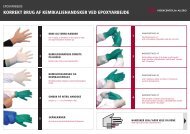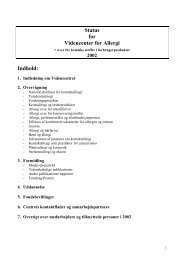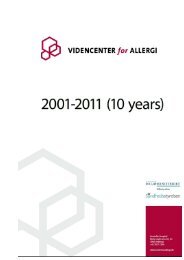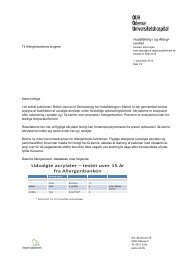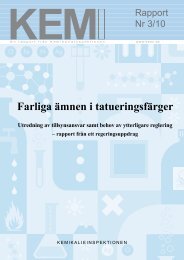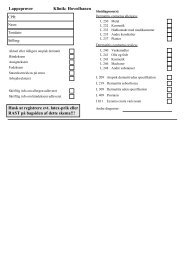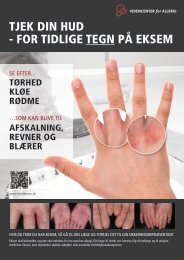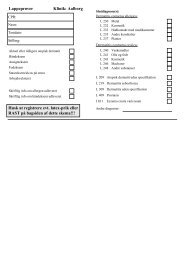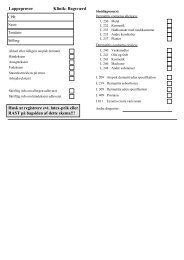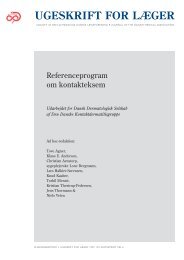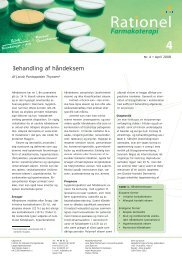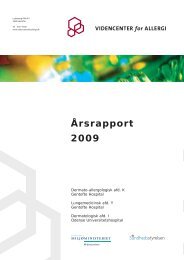Charlotte Devantier Jensen.pmd - Videncenter for Allergi
Charlotte Devantier Jensen.pmd - Videncenter for Allergi
Charlotte Devantier Jensen.pmd - Videncenter for Allergi
You also want an ePaper? Increase the reach of your titles
YUMPU automatically turns print PDFs into web optimized ePapers that Google loves.
18<br />
16<br />
14<br />
12<br />
10<br />
8<br />
6<br />
4<br />
2<br />
0<br />
Contact allergy to the preservative methyldibromoglutaronitrile 11<br />
MDBGN PATCH TEST CONCENTRATION AND VEHICLE<br />
An important diagnostic tool <strong>for</strong> allergic contact dermatitis is<br />
the epicutaneous patch test. Eczema patients are exposed to<br />
common and suspected allergens under controlled conditions<br />
and the skin response to the allergens is registered. To get reliable<br />
readings, it is important to expose the patients to concentrations<br />
of allergen that do not miss clinically relevant allergies<br />
and will not frequently produce false-positive irritant reactions.<br />
A commonly used MDBGN patch test concentration<br />
is 0.3% in petrolatum (pet). In recent experiments, however,<br />
the patch test concentration appears to miss clinically relevant<br />
cases of contact allergy (personal communication). The higher<br />
concentration of 0.5% MDBGN, though, often produces falsepositive<br />
irritant reactions, which means that some patients will<br />
be falsely diagnosed with contact allergy. But because of the<br />
risk of false-negative reactions it is being considered to recommend<br />
the use of a patch test concentration of 0.5% MDBGN<br />
in pet.<br />
EXPERIMENT EXAMINING THE MDBGN PATCH<br />
TEST VEHICLE<br />
The preferred MDBGN patch test vehicle is pet. Pet. is popular<br />
as vehicle because of its ability to provide efficient occlusion,<br />
keep allergens stable and, moreover, it is easy to work<br />
with. It is, however, difficult to dose pet. accurately and there<strong>for</strong>e<br />
it was decided to use an ethanol/water (eth./aq.) mixture<br />
as vehicle in the experiments of this thesis. Ethanol was added<br />
to ensure that the MDBGN was properly dissolved, as its solubility<br />
in water is limited.<br />
Fig. 4. Patch test reactions of<br />
19 consecutive patients to<br />
MDBGN in pet. and eth./aq.<br />
Some patients had reactions to<br />
several of or all test solutions.<br />
Number of reactions<br />
To examine and compare the patch test response to MDBGN<br />
in eth./aq. and MDBGN in pet., a small experiment was per<strong>for</strong>med.<br />
20 consecutive patients were patch tested with<br />
MDBGN in 3 concentrations: 0.1%, 0.3% and 0.5% in both<br />
pet. and a 50:50 mixture of eth./aq. The patch test results are<br />
presented in Fig. 4. 19 of the tested patients had a patch test<br />
response on D3 to at least one of the patches with at least one<br />
doubtful, positive or irritative reaction. The test size is limited,<br />
but some tendencies were observed: a) MDBGN in eth./aq.<br />
caused significantly more visibly irritative reactions than<br />
MDBGN in pet. at the concentrations of 0.3% and 0.5%. Frequent<br />
irritative reactions from Euxyl K 400 in ethanol have<br />
been reported earlier 37 . b) With eth./aq. as vehicle, 3 patients<br />
had a positive reaction (+) to at least one of the patch test concentrations<br />
compared to 1 person with pet. as vehicle. c) Doubtful<br />
reactions were frequent <strong>for</strong> all patches except 0.1% pet.<br />
Most of these reactions are probably weak irritative reactions.<br />
In general, stronger patch test responses with frequent irritative<br />
reactions were seen to MDBGN in eth./aq. than to<br />
MDBGN in pet. This was supported by patch test results from<br />
Trial I of this project. The patients in Trial I were patch tested<br />
with a dilution series of MDBGN (0.2%–0.001%) in eth./aq.<br />
(50:50) along with a patch of 0.3% MDBGN pet. to compare<br />
the patch test responses. (The highest concentration chosen in<br />
the dilution series was 0.2% MDBGN eth./aq. to avoid most<br />
irritative reactions). 0.2% MDBGN eth./aq. generally produced<br />
a patch test response equal to or stronger than 0.3% MDBGN<br />
pet. (Table 3). Feasible explanations <strong>for</strong> the augmented response<br />
with the eth./aq. vehicle are a greater penetration of<br />
0.1% 0.3% 0.5% 0.1% 0.3% 0.5%<br />
Ethanol/aq Petrolatum<br />
Irritative<br />
Positive<br />
Doubtful<br />
Forum <strong>for</strong> Nord Derm Ven Vol. 10, 2005 – Suppl. 8




